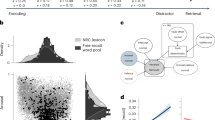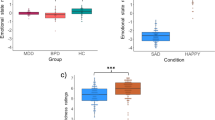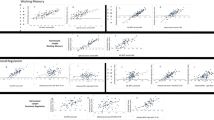Abstract
Dysfunction in emotion regulation (ER) and autobiographical memory are components of major depressive disorder (MDD). However, little is known about how they mechanistically interact with mood disturbances in real time. Using machine learning-based neural signatures, we can quantify negative affect (NA), ER, and memory continuously to evaluate how these processes dynamically interact in MDD. Unmedicated individuals with MDD (N = 45) and healthy volunteers (HV; N = 38) completed a negative autobiographical memory functional magnetic resonance imaging task wherein they recalled, distanced from (an ER strategy), and immersed into memories. We used a negative affect signature (PINES) and an emotion regulation signature (ERS) to quantify moment-to-moment NA and ER. We then examined whether memory engagement, indexed by hippocampal activity, predicted subsequent change in PINES and ERS over time. During memory recall and immersion, greater hippocampal activity predicted increased PINES across groups. During distancing, greater hippocampal activity in HVs predicted increased ERS but not PINES. In MDD, greater hippocampal activity predicted increased PINES but not ERS. Findings suggest abnormalities in the real-time relationship between memory, NA, and ER in MDD. During distancing, as predicted, HVs showed an attenuation of the linkage between memory engagement and NA, and they had subsequent increases in ER following memory reactivation. In contrast, MDD was characterized by continued linkage between memory engagement and NA, without subsequent increases in ER. Deficits in engagement of ER and ineffective modulation of NA following negative memory recall may contribute to the mood disturbances in MDD and are potential targets for clinical intervention.
This is a preview of subscription content, access via your institution
Access options
Subscribe to this journal
Receive 12 print issues and online access
$259.00 per year
only $21.58 per issue
Buy this article
- Purchase on SpringerLink
- Instant access to full article PDF
Prices may be subject to local taxes which are calculated during checkout





Similar content being viewed by others
Data availability
Deidentified data is available from the corresponding author upon request.
References
Friedrich MJ. Depression is the leading cause of disability around the world. JAMA. 2017;317:1517.
Dalgleish T, Werner-Seidler A. Disruptions in autobiographical memory processing in depression and the emergence of memory therapeutics. Trends Cogn Sci. 2014;18:596–604.
Disner SG, Beevers CG, Haigh EA, Beck AT. Neural mechanisms of the cognitive model of depression. Nat Rev Neurosci. 2011;12:467–77.
Joormann J, Stanton CH. Examining emotion regulation in depression: a review and future directions. Behav Res Ther. 2016;86:35–49.
Liu DY, Thompson RJ. Selection and implementation of emotion regulation strategies in major depressive disorder: an integrative review. Clin Psychol Rev. 2017;57:183–94.
Visted E, Vøllestad J, Nielsen MB, Schanche E. Emotion regulation in current and remitted depression: a systematic review and meta-analysis. Front Psychol. 2018;9:756.
Rayner G, Jackson G, Wilson S. Cognition-related brain networks underpin the symptoms of unipolar depression: evidence from a systematic review. Neurosci Biobehav Rev. 2016;61:53–65.
Conway MA, Pleydell-Pearce CW. The construction of autobiographical memories in the self-memory system. Psychol Rev. 2000;107:261.
Gotlib IH, Joormann J. Cognition and depression: current status and future directions. Annu Rev Clin Psychol. 2010;6:285–312.
Joormann J, Siemer M. Memory accessibility, mood regulation, and dysphoria: difficulties in repairing sad mood with happy memories? J Abnorm Psychol. 2004;113:179.
Joormann J, Siemer M, Gotlib IH. Mood regulation in depression: differential effects of distraction and recall of happy memories on sad mood. J Abnorm Psychol. 2007;116:484.
Werner-Seidler A, Moulds ML. Autobiographical memory characteristics in depression vulnerability: formerly depressed individuals recall less vivid positive memories. Cogn Emot. 2011;25:1087–103.
Young KD, Bellgowan PS, Bodurka J, Drevets WC. Behavioral and neurophysiological correlates of autobiographical memory deficits in patients with depression and individuals at high risk for depression. JAMA Psychiatry. 2013;70:698–708.
Dalgleish T, Yiend J. The effects of suppressing a negative autobiographical memory on concurrent intrusions and subsequent autobiographical recall in dysphoria. J Abnorm Psychol. 2006;115:467.
Park C, Rosenblat JD, Lee Y, Pan Z, Cao B, Iacobucci M, et al. The neural systems of emotion regulation and abnormalities in major depressive disorder. Behav Brain Res. 2019;367:181–8.
Doré BP, Rodrik O, Boccagno C, Hubbard A, Weber J, Stanley B, et al. Negative autobiographical memory in depression reflects elevated amygdala-hippocampal reactivity and hippocampally associated emotion regulation. Biol Psychiatry Cogn Neurosci Neuroimaging. 2018;3:358–66.
Gross JJ, Thompson RA. Emotion regulation: conceptual foundations. Handbook of Emotion Regulation; (Guilford Press. New York, NY. 2006).
John OP, Gross JJ. Healthy and unhealthy emotion regulation: personality processes, individual differences, and life span development. J Pers. 2004;72:1301–34.
Haxby JV, Gobbini MI, Furey ML, Ishai A, Schouten JL, Pietrini P. Distributed and overlapping representations of faces and objects in ventral temporal cortex. Science. 2001;293:2425–30.
Chang LJ, Gianaros PJ, Manuck SB, Krishnan A, Wager TD. A sensitive and specific neural signature for picture-induced negative affect. PLoS Biol. 2015;13:e1002180.
Schneck N, Herzog S, Lu J, Yttredahl A, Ogden RT, Galfalvy H, et al. The temporal dynamics of emotion regulation in subjects with major depression and healthy control subjects. Biol Psychiatry. 2023;93:260–7.
Weaverdyck ME, Lieberman MD, Parkinson C. Tools of the trade multivoxel pattern analysis in fMRI: a practical introduction for social and affective neuroscientists. Soc Cogn Affect Neurosci. 2020;15:487–509.
McLaren DG, Ries ML, Xu G, Johnson SC. A generalized form of context-dependent psychophysiological interactions (gPPI): a comparison to standard approaches. Neuroimage. 2012;61:1277–86.
First MB, Gibbon M. The structured clinical interview for DSM-IV axis I disorders (SCID-I) and the structured clinical interview for DSM-IV axis II disorders (SCID-II). Comprehensive handbook of psychological assessment, Vol. 2: Personality assessment. Hoboken, NJ, US: John Wiley & Sons, Inc.; 2004. p. 134–43.
Stark CE, Squire LR. When zero is not zero: the problem of ambiguous baseline conditions in fMRI. Proc Natl Acad Sci USA. 2001;98:12760–6.
Esteban O, Blair RW, Nielson DM, Varada JC, Marrett S, Thomas AG, et al. Crowdsourced MRI quality metrics and expert quality annotations for training of humans and machines. Sci Data. 2019;6:30.
Esteban O, Markiewicz CJ, Blair RW, Moodie CA, Isik AI, Erramuzpe A, et al. fMRIPrep: a robust preprocessing pipeline for functional MRI. Nat Methods. 2019;16:111–6.
Iglesias JE, Augustinack JC, Nguyen K, Player CM, Player A, Wright M, et al. A computational atlas of the hippocampal formation using ex vivo, ultra-high resolution MRI: application to adaptive segmentation of in vivo MRI. Neuroimage. 2015;115:117–37.
Addis DR, Moscovitch M, Crawley AP, McAndrews MP. Recollective qualities modulate hippocampal activation during autobiographical memory retrieval. Hippocampus. 2004;14:752–62.
Davachi L. Item, context and relational episodic encoding in humans. Curr Opin Neurobiol. 2006;16:693–700.
Eldridge LL, Knowlton BJ, Furmanski CS, Bookheimer SY, Engel SA. Remembering episodes: a selective role for the hippocampus during retrieval. Nat Neurosci. 2000;3:1149–52.
Sheldon S, Fenerci C, Gurguryan L. A neurocognitive perspective on the forms and functions of autobiographical memory retrieval. Front Syst Neurosci. 2019;13:4.
Sheldon S, Levine B. The role of the hippocampus in memory and mental construction. Ann N Y Acad Sci. 2016;1369:76–92.
Conroy BR, Walz JM, Cheung B, Sajda P. Fast simultaneous training of generalized linear models (FaSTGLZ). arXiv preprint arXiv:13078430 2013.
Acknowledgements
This work was support by the National Institute of Mental Health P50 MH090964 (PI: J. Mann) and 5T32MH015144-46 (PI: D. Leonardo).
Author information
Authors and Affiliations
Contributions
CAM: project conception, design, data analysis, and writing of the manuscript. NS, LD: project design and data analysis, comments on manuscript. JJM, KNO: grant design and funding, comments on manuscript. MS: preprocessing, assistance with data analysis & figure design, comments on manuscript. SH: comments on manuscript. All authors reviewed and approved the final version of the manuscript.
Corresponding author
Ethics declarations
Competing interests
JJM receives royalties from the Research Foundation for Mental Hygiene for commercial use of the C-SSRS. CAM, MS, SH, KNO, LD, and NS have no conflicts to report.
Additional information
Publisher’s note Springer Nature remains neutral with regard to jurisdictional claims in published maps and institutional affiliations.
Supplementary information
Rights and permissions
Springer Nature or its licensor (e.g. a society or other partner) holds exclusive rights to this article under a publishing agreement with the author(s) or other rightsholder(s); author self-archiving of the accepted manuscript version of this article is solely governed by the terms of such publishing agreement and applicable law.
About this article
Cite this article
Michel, C.A., Schmidt, M., Mann, J.J. et al. Temporal interactions between neural proxies for memory recall, negative affect, and emotion regulation in major depression. Mol Psychiatry 30, 4039–4046 (2025). https://doi.org/10.1038/s41380-025-02982-6
Received:
Revised:
Accepted:
Published:
Issue date:
DOI: https://doi.org/10.1038/s41380-025-02982-6



